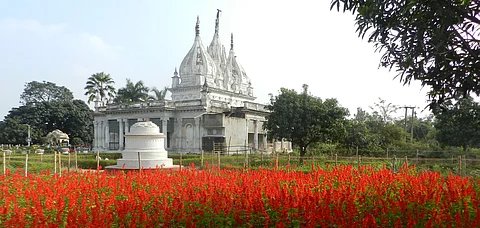

Way back in the 18th century, Murshidabad was the capital of Nawabs of Bengal and an important trading centre dealing in muslin, silk, ivory and other material. It was at this time that a few Jain families from Rajasthan (mostly Oswal Jains) settled here as traders and bankers. Although the families shifted base when the trading hub shifted to Kolkata with the ascendancy of the British, the legacy that these families had built through palatial homes, temples and gardens, still survive.
As the men would go to the capital city (&lsquosheher&rsquo) of Murshidabad for business while staying in Azimganj and Jiaganj, twin towns on either banks of Bhagirathi River (the name given to Ganga as it enters West Bengal), they gradually came to be known as &lsquoSheherwali&rsquo or &lsquoone who goes to the city&rsquo. The families adapted to their second homeland with ease while retaining characteristics of the first. Apart from palatial homesteads and Jain temples, the Sheherwali-s also added a unique chapter to the culinary repertoire of Bengal.

You may easily delve into the Sheherwali legacy across Murshidabad, Jiaganj and Azimganj while on a vacation to this former kingdom of the former Nawabs of Bengal.
A popular attraction on a customary tour of Murshidabad is the Kathgola Palace and Garden. Built by wealthy merchants Dhanpat Singh Dugar and Lakshmipat Singh Dugar of Jiaganj in 1873, it is a sprawling garden with Jain temples, a palace and a zoo inside. The palace has been converted to a museum and showcases magnificent chandeliers, mirrors, furniture, etc.
Although a shadow of its former glory, the palatial home of the Jagat Seth family, has been converted to a museum. Oswal Jains, Manick Chand and Fateh Chand, not only established a flourishing trading empire in the 18th century but also served as bankers. It was their achievement in the banking business that earned the family the title of Jagat Seth or &lsquobanker of the world&rsquo. The family had joined hands with Robert Clive of the East India Company in his fight with Nawab Sirj-ud-daula of Bengal.

Some of the popular Jain temples in Jiaganj are that of Parasnath, Sambhavanath, Vimalnath and Rishabhdev Adinath.
Take a local ferry and cross to Azimganj. The boat ride offers a panoramic view of the countryside along both banks. You will find a concentration of old Sheherwali homesteads and Jain temples in the neighbourhood popularly known as the Jainpatty. Some of the popular Jain temples here are that of Chintamani Parasnath, Neminath, Sambhavanath, etc.
While in Azimganj, do not miss the Hindu temples of Bor-nagar. Rani Bhavani, the widowed wife of a zamindar of Natore (now in Bangladesh), was fondly called the queen (rani) owing to her pious and social welfare activities. It was she who had commissioned several temples here. Right on the riverbank is the richly carved Charbangla terracotta temple. Scattered in the vicinity are several other temples patronised by her but now in various stages of neglect.

Recently, present generations of the Sheherwali families are taking a keen interest in restoring the old family homes and promoting tourism in the area. The ancestral home of the Dudhoria family, Bari Kothi, built in the early 18th century, showcasing Greek, Roman and French architecture, has been carefully restored. According to the owners, it will soon be launched as a luxury heritage hotel. As most homesteads remain locked up for the greater part of the year and require special permission to visit, one of the best time to visit the area is during the heritage festival organised by the Murshidabad Heritage Development Society (https://www.mhds.in/), which includes tours of Murshidabad, Jiaganj and Azimganj. The festival is also one of the rare opportunities to try the unique Sheherwali cuisine, essentially Rajasthani Jain food influenced by locally available ingredients. The Sheherwali cuisine borrowed liberally from its surrounding cultures&mdashNawabi, Bengali and European. So the famous Bengal spice&mdashpanch phoron&mdashfound its way into the cuisine while the Nawabi influence led to liberal use of rose water, saffron and dry fruits.
Getting there Azimganj-Jiaganj is connected to Kolkata by road and rail. The most convenient way to travel is by train, Bhagirathi Express or the Hazarduari Express, and get down at Baharampur (Berhampur) Court Railway Station. Although budget hotels are available in Azimganj-Jiaganj and Murshidabad, Baharampur offers better stay options. You may try The Fame (https://www.thefamehotel.com/) located very near the railway station. Winter is the best time to travel.
